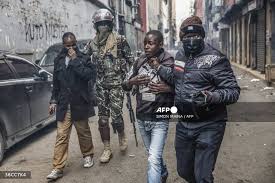Kenyan police fired volleys of tear gas yesterday in the heart of the capital Nairobi as small groups of protesters gathered on what was billed as a fresh day of action against embattled President William Ruto.
Riot police patrolled the streets of the central business district, roadblocks were set up on major arteries and many shops were shut, but only a few dozen demonstrators turned out, chanting “we are peaceful”.
The East African nation, one of the most stable in the region, has been rocked by weeks of sometimes deadly protests against Ruto’s two-year-old administration, mostly led by young Gen-Z Kenyans.
While Ruto was overseeing the swearing-in of a revamped cabinet, just a few kilometres (miles) away police lobbed tear gas in the central business district and detained several people. But otherwise, the streets appeared largely quiet, with a few people going about their normal business. Television footage from the Indian Ocean city of Mombasa showed traffic flowing normally and no signs of trouble, and the western lakeside city of Kisumu was also reported to be calm.
Stephens Wanjiku, a 29-year-old fashion stylist, said she had taken to the streets since the demonstrations began in mid-June to demand “good governance and accountability”.
“I have been beaten,” Wanjiku, sporting a bright blue robe, ski goggles and multiple masks, told AFP in Nairobi, saying police brutality should be a “thing of the past, we should not be seeing it in 2024”.
Kenya’s acting police chief Gilbert Masengeli had warned on Wednesday that “criminals” intended to infiltrate the demonstrations and advised people to stay away from protected zones such as the main international airport and Ruto’s official residence and take precautions in crowded areas.
What started out as peaceful youth-led rallies against controversial proposed tax hikes has ballooned into wider action against Ruto and what many see as profligate government spending and corruption.
At least 60 people have been killed since they began, with police accused of using excessive force, sometimes firing live bullets, while dozens of people have gone missing, according to rights groups.
While the rallies have become smaller in recent weeks, posters shared online called for fresh demonstrations Thursday, dubbed “Nane Nane” or Eight Eight in Swahili, to signify the date, August 8.
Organisers have in the past accused “goons” of hijacking their plans for peaceful action and of stoking violence.
In a bid to tackle the worst crisis of his presidency, Ruto has taken a series of measures to address public anger including scrapping the tax hikes, rejigging his cabinet and making deep budget cuts.
He said Thursday’s installation of a new “broad-based” cabinet — which includes four opposition stalwarts but also a number of previously sacked ministers — represented the start of a “new chapter” for Kenya’s governance and development.
Ruto took office in September 2022 after winning a closely fought and divisive election against veteran opposition leader Raila Odinga, pledging to work for Kenya’s poor and downtrodden.
But he has found himself caught between the demands of international lenders to shore up government finances to enable it to service its massive $78-billion debt, and ordinary Kenyans who are struggling with a cost-of-living crisis.
While economic growth has remained relatively strong, estimated by the central bank at 5.4 per cent this year, a third of the country’s 52 million people live in poverty.
Edwin Kagia, a 24-year-old man trying to eke out a living selling masks, said Ruto should be given a chance.
“We have to wait. Right now what Kenya needs today… is to give our president time,” he told AFP.


